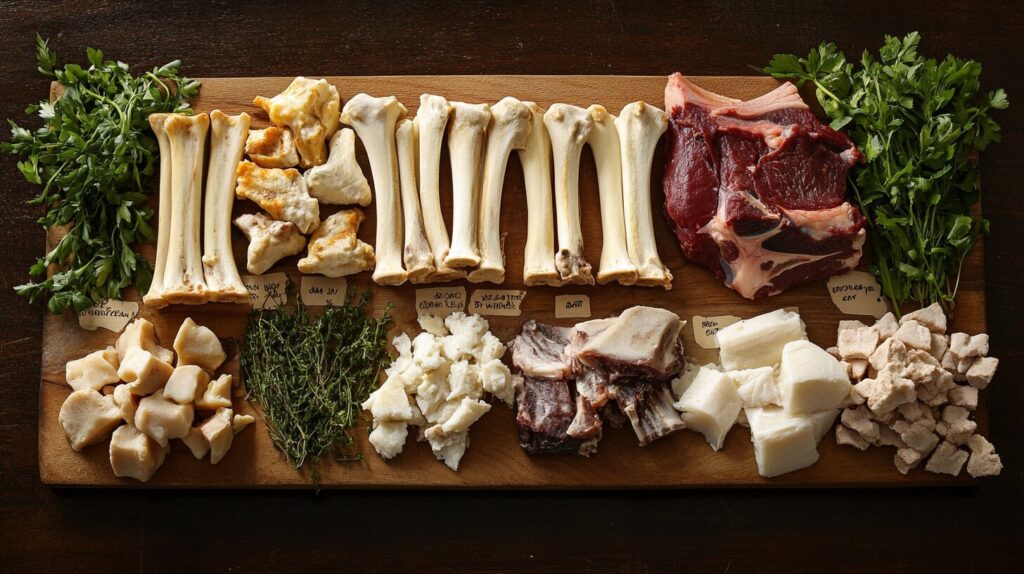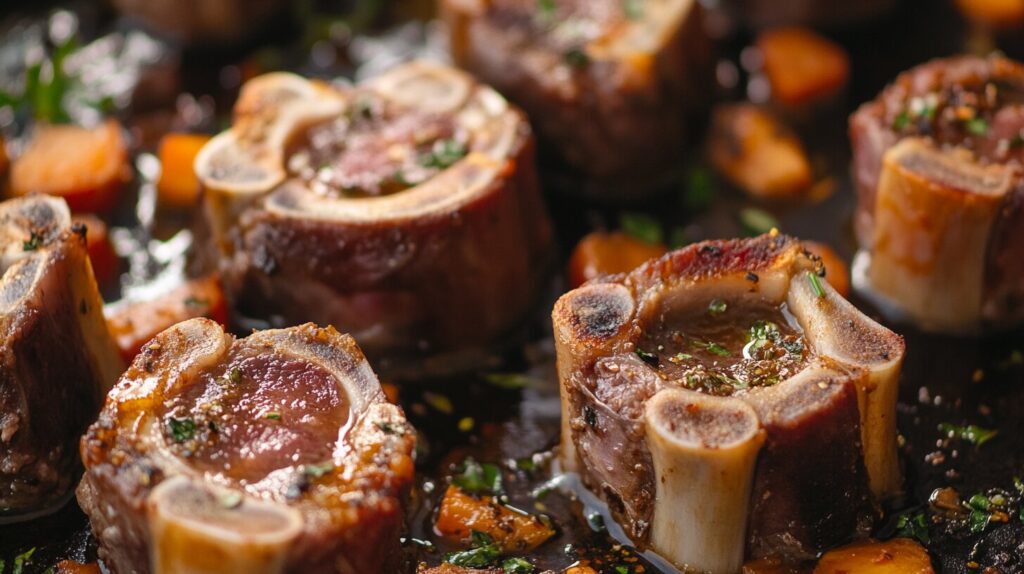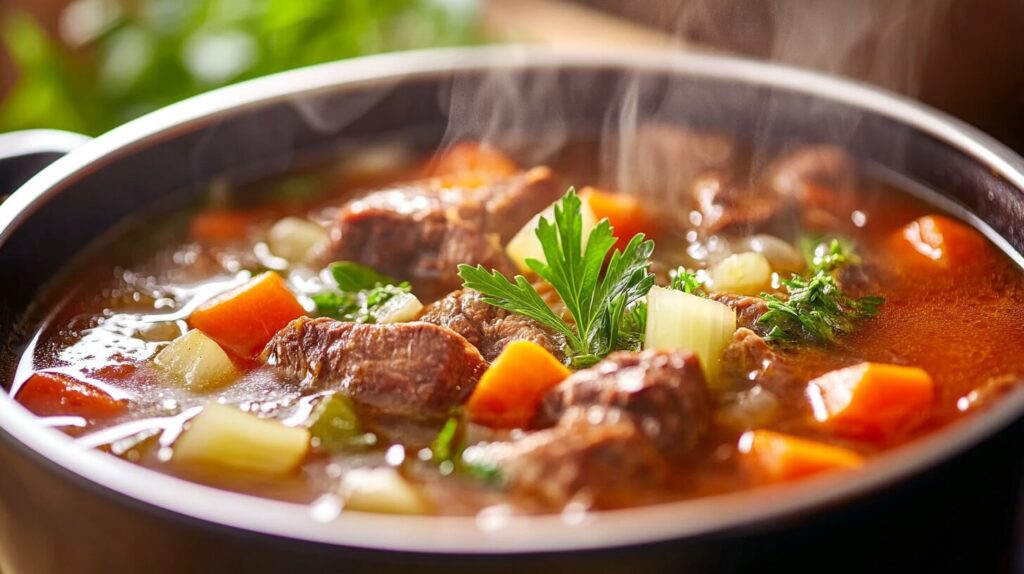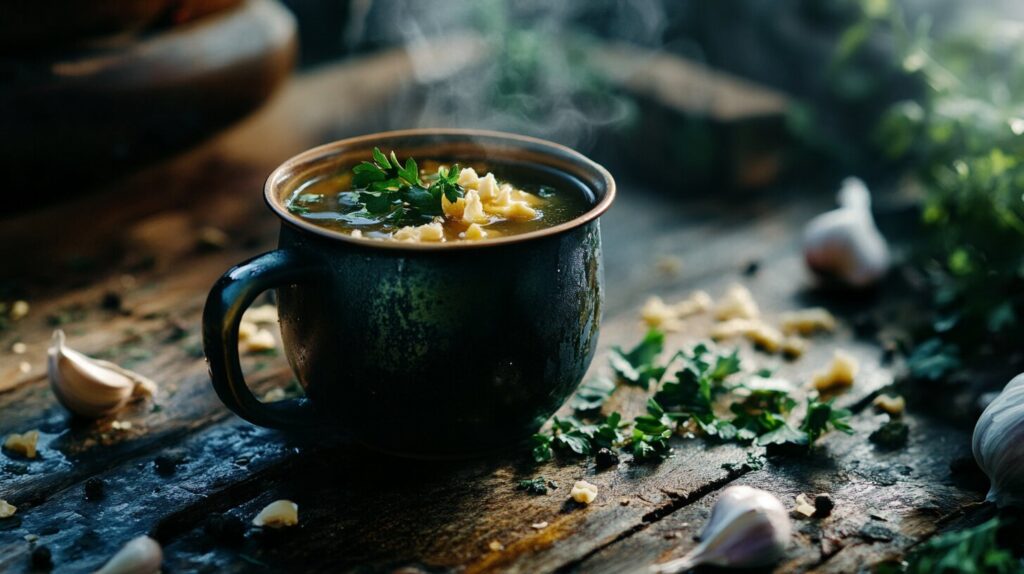Soup bones might not be the most glamorous ingredient in your kitchen, but they’re absolute gold when it comes to creating rich, nutritious broths and soups. If you’ve ever savored a bowl of hearty homemade soup and wondered what gave it that deep, comforting flavor, soup bones likely played a starring role. Whether you want to whip up a healthy broth, enhance your cooking skills, or reap fantastic health benefits, understanding soup bones is essential.
So, let’s dive deep into everything you need to know about soup bones: their types, nutritional value, how to use them, and why they should be part of your regular cooking routine. 🥣
Table of Contents
Understanding the Basics of Soup Bones
Soup bones are simply animal bones that you use to create soups, stocks, and broths. These bones usually have bits of meat, cartilage, and connective tissue attached. All these elements contribute to the flavor and richness of your final dish. When you simmer these bones slowly, they release gelatin, minerals, and collagen, which give your broth a nutrient-dense boost.

Soup bones typically come from beef, chicken, lamb, or fish. Each type of bone offers a unique flavor profile and nutritional benefit. Additionally, the slow cooking process helps extract amino acids, calcium, and other essential minerals that your body loves.
Here’s the kicker: even though soup bones seem humble, they serve as the backbone of countless flavorful recipes (pun intended)! 😂
“Soup bones are nature’s multivitamin—packed with minerals, nutrients, and flavor in one simple package.”
Types of Soup Bones: A Comprehensive Guide
Let’s break down the different types of soup bones you can use in your cooking and explore the unique flavors and benefits they offer.

Beef Bones for Soup
When it comes to rich, hearty broths, beef bones are the MVPs. They create dark, deeply flavored broths that are perfect for stews and soups. You can use various types of beef bones, such as:
- Marrow Bones: These bones are filled with rich, buttery marrow that adds a luxurious mouthfeel to your broth.
- Knuckle Bones: These are packed with collagen and work perfectly for making gelatin-rich broths.
- Oxtail: This hidden gem offers a rich, beefy flavor.
Flavor Profile: Beef bones provide a robust and intense flavor, making them ideal for classic beef stock, ramen, or French onion soup.
Additionally, beef bones are perfect for slow-cooking methods, allowing you to extract every nutrient and bit of flavor over time.
Chicken Bones for Broth
Chicken bones are super versatile and a staple for home cooks. They make a lighter broth compared to beef. However, they still deliver comfort and nourishment. You can use various chicken bones, such as:
- Carcass: These are the leftover bones from a roasted chicken.
- Necks and Backs: These parts are great for extracting maximum flavor and collagen.
- Wings: These bones are high in cartilage, which helps create a thicker, gel-like broth.
Flavor Profile: Chicken bone broth offers a mild, savory flavor that works well for soups, sauces, and gravies. Think of classic chicken noodle soup or a cozy chicken and rice dish. 🐔
“Chicken bone broth is like a warm hug in a mug—comforting, healing, and absolutely delicious.”
Moreover, chicken bones are easy to find and budget-friendly, making them an excellent option for regular use in your kitchen.
Lamb Bones for Stock
Lamb bones are less common than beef or chicken bones, but they bring a distinct, savory flavor perfect for Mediterranean and Middle Eastern dishes. If you plan to make lamb stew, lentil soup, or curry, lamb bones are a fantastic choice.
Consider using these types of lamb bones:
- Neck Bones: These bones are flavorful and loaded with connective tissue.
- Shank Bones: They offer a lot of marrow and a deep flavor.
Flavor Profile: Lamb broth has an earthy, slightly gamey, and rich taste. If you love bold flavors, lamb bones are a must-try.
On the other hand, if you prefer a more neutral flavor, you might want to stick with chicken or beef bones.
Fish Bones for Clear Broth
Fish bones create clear, delicate broths that are perfect for seafood soups and risottos. They often appear in Asian and Mediterranean cooking. Typically, fish bones come from white fish like:
- Snapper
- Halibut
- Cod
Flavor Profile: Fish broth has a light, clean, and slightly briny flavor. You can use it for dishes like miso soup, bouillabaisse, or seafood chowder. 🐟
Additionally, fish bones cook much faster than beef or chicken bones, making fish broth a quick and easy option when you’re short on time.
Nutritional Benefits of Soup Bones
Soup bones aren’t just about flavor—they’re loaded with essential nutrients that support your health. Let’s take a look at why soup bones are a nutritional powerhouse.
Essential Minerals Found in Soup Bones
When you simmer soup bones, you extract a treasure trove of minerals like:
- Calcium: This mineral is essential for strong bones and teeth.
- Magnesium: It supports heart health and muscle function.
- Phosphorus: Your body uses phosphorus to produce energy.
These minerals dissolve into the broth in an easy-to-absorb form. Therefore, drinking bone broth offers a convenient way to boost your nutrient intake.
Why Bone Broth is a Superfood
Bone broth has earned its title as a superfood for good reason. It contains:
- Collagen: This protein supports healthy skin, joints, and hair.
- Gelatin: It aids digestion and helps heal your gut lining.
- Amino Acids: Compounds like glycine, proline, and glutamine reduce inflammation and support your immune system.
Furthermore, regularly consuming bone broth can improve your joint health, enhance your gut function, and give you glowing skin. It’s like a beauty and wellness potion brewed right in your kitchen! ✨
How to Choose the Best Soup Bones
Selecting the best soup bones is key to making a rich, flavorful broth. Follow these tips to ensure you get high-quality bones.
Factors to Consider When Buying Bones
When you choose soup bones, pay attention to these factors:
- Freshness: Always choose fresh bones rather than frozen ones, if possible.
- Marrow Content: Opt for bones with plenty of marrow to add richness to your broth.
- Color: Good-quality bones should have a healthy pink or red color rather than a gray or dull appearance.
In addition, organic and grass-fed bones are ideal if you want to avoid unwanted additives.
Where to Source High-Quality Bones
You can find high-quality soup bones in several places:
- Butcher Shops: Local butchers often offer a great selection of bones.
- Farmers’ Markets: These markets are excellent for finding grass-fed and organic options.
- Grocery Stores: Many supermarkets stock pre-packaged soup bones.
- Online: Specialty websites deliver high-quality, ethically sourced bones right to your door.
🥘 Making soup with bones feels like a lost art, but it’s an easy, affordable, and incredibly nourishing way to cook. Give it a try and unlock a world of flavor!
Common Problems with Soup Bones and Their Solutions
Even though making bone broth seems simple, a few challenges can pop up. Fortunately, you can avoid these pitfalls with the right techniques and a little know-how. Let’s go over the most common issues and how to fix them.
Dealing with Cloudy Broth
Cloudy broth is a common issue when making bone broth. It typically happens because the broth was boiled too vigorously or stirred too much during cooking.
Solution:
- Simmer gently: To keep your broth clear, bring it to a boil and immediately lower the heat to a gentle simmer. The surface should barely bubble.
- Avoid stirring: Once the broth is simmering, try not to disturb it. Let it cook undisturbed for the best results.
- Skim impurities: Use a ladle or spoon to skim off any foam or impurities that rise to the top during the first 30 minutes of cooking. This helps keep your broth clear.
Removing Excess Fat from Broth
Sometimes your broth might end up with an oily layer on top. While some fat is good for flavor, too much can make the broth greasy.
Solution:
- Chill the broth: After cooking, let your broth cool and refrigerate it for several hours. The fat will solidify on the surface, making it easy to remove.
- Use a fat separator: This handy kitchen tool lets you pour out the broth while leaving the fat behind.
- Skim during cooking: Periodically skim the fat off the top of the simmering broth with a spoon or ladle.
Preventing Bitter Flavor in Bone Broth
A bitter flavor can ruin an otherwise perfect broth. This often happens if you overcook the bones, use burned bones, or don’t balance the flavors.
Solution:
- Roast carefully: If you’re roasting the bones before simmering, make sure they’re golden brown, not charred.
- Add vegetables and herbs: Ingredients like onions, carrots, celery, garlic, and herbs can balance the flavors and prevent bitterness.
- Don’t overcook: For chicken bones, simmer for 6-8 hours. For beef or lamb bones, aim for 12-24 hours. Overcooking can lead to a bitter taste.
“Remember, patience and gentle cooking are the keys to a perfect broth.” 🥣
Step-by-Step Guide to Making Bone Broth
Now that we’ve covered the potential pitfalls, let’s get into the fun part: making your own bone broth! Whether you prefer using the stovetop, Instant Pot, or slow cooker, this guide has you covered.

Ingredients You’ll Need
Gather the following ingredients before you start:
- Soup Bones: 2-3 pounds of beef, chicken, lamb, or fish bones
- Vegetables: 2 carrots, 2 celery stalks, and 1 onion, roughly chopped
- Garlic: 2-3 cloves, smashed
- Apple Cider Vinegar: 2 tablespoons (helps extract minerals from the bones)
- Herbs and Spices: Bay leaves, thyme, parsley, peppercorns, and salt
- Water: Enough to cover the bones (about 10-12 cups)
Preparing Your Bones for Broth
- Roast the Bones:
- For beef or lamb bones, preheat your oven to 400°F (200°C). Place the bones on a baking sheet and roast them for 30-45 minutes until they’re golden brown. This step adds depth and richness to your broth.
- For chicken bones, roasting is optional, but it enhances the flavor. Roast for 20-30 minutes at 400°F (200°C).
- Skip roasting for fish bones, as it can overpower the delicate flavor.
- Prepare the Vegetables:
- Roughly chop the carrots, celery, and onion. Smashing the garlic helps release more flavor.
Cooking Methods
You can choose from three popular methods to cook your bone broth: the stovetop, Instant Pot, or slow cooker.
Stovetop Method
- Add Ingredients to a Large Pot:
- Place the roasted bones, vegetables, garlic, and herbs in a large stockpot.
- Add 2 tablespoons of apple cider vinegar and cover everything with water.
- Bring to a Boil and Simmer:
- Bring the pot to a boil, then immediately reduce the heat to a gentle simmer.
- Simmer chicken bones for 6-8 hours and beef or lamb bones for 12-24 hours.
- Skim and Strain:
- Periodically skim off any foam or fat from the surface.
- Once finished, strain the broth through a fine-mesh sieve into a large bowl.
Instant Pot Method
- Add Ingredients to the Instant Pot:
- Place the bones, vegetables, garlic, herbs, and vinegar in the Instant Pot. Cover with water, but don’t exceed the “Max Fill” line.
- Pressure Cook:
- Close the lid and set the valve to “Sealing.” Cook on high pressure for 2 hours for beef bones and 1 hour for chicken bones.
- Release Pressure and Strain:
- Let the pressure release naturally for at least 20 minutes. Then strain the broth.
Slow Cooker Method
- Add Ingredients to the Slow Cooker:
- Combine the bones, vegetables, garlic, herbs, and vinegar in the slow cooker. Add enough water to cover the ingredients.
- Cook on Low:
- Set the slow cooker to “Low” and cook for 12-24 hours for beef bones or 6-8 hours for chicken bones.
- Strain the Broth:
- Once the cooking time is complete, strain the broth through a sieve.
Straining and Storing Broth
- Strain the Broth:
- Use a fine-mesh sieve or cheesecloth to remove the bones and vegetables. Discard the solids.
- Cool and Store:
- Let the broth cool to room temperature. Refrigerate it for up to 5 days or freeze it for up to 6 months.
“Pro tip: Freeze your broth in ice cube trays for quick, easy portions to use in recipes!” 🧊
Delicious Recipes Using Soup Bones
Bone broth is not just for sipping—it’s the perfect base for a wide variety of comforting and flavorful dishes. Let’s look at some classic and creative ways to use your homemade broth.
Classic Beef Bone Broth Recipe
This beef bone broth recipe is a rich, hearty base for soups, stews, and even sipping straight from a mug.
Ingredients:
- 2-3 pounds beef soup bones (marrow bones, knuckles, or oxtail)
- 2 carrots, chopped
- 2 celery stalks, chopped
- 1 onion, quartered
- 4 garlic cloves, smashed
- 2 tablespoons apple cider vinegar
- Water (enough to cover the bones)
- Fresh herbs (thyme, rosemary, and parsley)
- Salt and pepper to taste
Instructions:
- Roast the Bones: Preheat the oven to 400°F (200°C). Place the bones on a baking sheet and roast for 45 minutes until golden brown.
- Combine Ingredients: Place the roasted bones, vegetables, garlic, herbs, and vinegar in a large pot. Cover with water.
- Simmer: Bring to a boil, then reduce heat to a gentle simmer. Cook for 12-24 hours, skimming impurities occasionally.
- Strain: Strain through a fine-mesh sieve and season with salt and pepper. Enjoy warm!
Chicken Broth with Herbs
This light, savory chicken broth works wonders in soups, risottos, or sauces.
Ingredients:
- 1 chicken carcass or 2-3 pounds chicken wings/necks
- 2 carrots, chopped
- 2 celery stalks, chopped
- 1 onion, quartered
- 2 garlic cloves, smashed
- 2 tablespoons apple cider vinegar
- Fresh herbs (parsley, thyme, and bay leaves)
- Salt and pepper to taste
Instructions:
- Roast the Bones: Optional—roast the bones at 400°F (200°C) for 30 minutes.
- Combine Ingredients: Add the bones, vegetables, garlic, herbs, and vinegar to a pot. Cover with water.
- Simmer: Bring to a boil, reduce heat, and simmer for 6-8 hours.
- Strain and Season: Strain the broth and season with salt and pepper.
“This broth makes the perfect base for chicken noodle soup on a cold day!” 🍜
Lamb Bone Broth for Middle Eastern Dishes
Lamb bone broth offers a rich, earthy flavor that pairs beautifully with Middle Eastern spices.
Ingredients:
- 2 pounds lamb neck bones or shanks
- 1 onion, quartered
- 2 carrots, chopped
- 2 garlic cloves, smashed
- 2 tablespoons apple cider vinegar
- Spices: 1 cinnamon stick, 2 bay leaves, and 1 teaspoon cumin
- Fresh herbs (mint or parsley)
- Salt and pepper to taste
Instructions:
- Roast the Bones: Roast lamb bones at 400°F (200°C) for 45 minutes.
- Combine Ingredients: Place bones, vegetables, garlic, vinegar, and spices in a pot. Cover with water.
- Simmer: Simmer for 12-24 hours.
- Strain and Season: Strain, season, and add fresh herbs.
This broth is fantastic for lentil soups, curries, or rice dishes.
Health and Wellness Benefits of Bone Broth
Bone broth is more than just a culinary staple—it’s a wellness powerhouse. Here’s how regular consumption can benefit your health.

How Bone Broth Supports Joint Health
Bone broth is packed with collagen and gelatin, which support healthy joints. These nutrients help maintain the integrity of your cartilage, which can wear down with age or activity.
The Role of Bone Broth in Gut Health
Bone broth contains glutamine, an amino acid that helps repair the gut lining. If you suffer from leaky gut syndrome or digestive issues, bone broth can be a soothing and healing addition to your diet.
Bone Broth for Immune System Support
The nutrients and minerals in bone broth, such as zinc and magnesium, can help boost your immune system. Additionally, the warmth and nourishment from broth can provide comfort during illness.
“Bone broth: your secret weapon for staying healthy, inside and out.” 💪
How to Store and Freeze Bone Broth
Proper storage ensures that your hard work doesn’t go to waste. Here are some tips for storing and freezing bone broth.
Tips for Freezing Bone Broth
- Cool the Broth First: Let the broth cool to room temperature before freezing.
- Use Portion-Sized Containers: Freeze broth in jars, silicone molds, or ice cube trays for easy portioning.
- Leave Room for Expansion: Leave at least 1 inch of space at the top of containers to allow for expansion.
Shelf Life of Bone Broth
- Refrigerated Broth: Store in the fridge for up to 5 days.
- Frozen Broth: Bone broth can stay good in the freezer for up to 6 months.
Bone Broth for Special Diets
Bone broth fits into a wide variety of diets. Here’s how you can incorporate it into different eating plans.
Bone Broth for Keto and Paleo Diets
Bone broth is low in carbs and high in nutrients, making it perfect for keto and paleo lifestyles. It provides essential electrolytes and supports hydration.
Incorporating Bone Broth into a Mediterranean Diet
The Mediterranean diet emphasizes whole foods and nutrient-dense ingredients. Bone broth works well in soups, stews, and sauces, adding both flavor and nutrition.
Frequently Asked Questions About Soup Bones
What are the best bones for making soup?
The best bones include beef marrow bones, chicken carcasses, lamb neck bones, and fish bones, depending on your desired flavor.
How long should you cook bone broth?
Cook chicken bones for 6-8 hours and beef or lamb bones for 12-24 hours. Fish bones only need 1-2 hours.
Can I reuse bones for a second batch of broth?
Yes, you can! The second batch will be lighter in flavor, but you’ll still get nutrients and minerals.
Is bone broth good for weight loss?
Yes! Bone broth is low in calories, high in protein, and helps keep you full.
How can I make bone broth taste better?
Add aromatic vegetables, herbs, and spices to enhance the flavor.
Conclusion
Soup bones might seem humble, but they unlock a world of flavor, nutrition, and wellness. Whether you’re crafting a rich beef broth, a delicate chicken broth, or a bold lamb stock, these bones are the key to homemade culinary magic. So grab some soup bones, fire up your stove, and let the simmering begin! 🥣🔥
Explore More Recipes and Cooking Guides 🍲
If you’re inspired to keep your culinary adventures going, we have plenty of resources to guide you! Learn more about the best ways to handle beef in our Comprehensive Beef Tips Guide. Not sure which cuts are best for your next stew? Check out Stew Meat vs. Beef Tips: Differences and Uses for tips on selecting the perfect meat. And if you want to dive deeper into bone broth basics, explore Everything You Need to Know About Soup Bones. These guides will turn you into a kitchen pro in no time! 🥄✨
